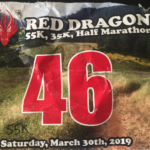So you wanna run an ultra?
| October 7, 2019 | Posted by Melinda under Uncategorized |
Except the people this post is directed to (who probably don’t even read this blog) don’t actually want to run an ultra. They just want to discuss how it can’t be that hard because at the paces most of the back-third of the pack is posting, we are just “walking.”
Oh don’t worry. It’s not any of you guys. My Dear Readers seem to take my word that an ultra, no matter what the pace, does not equal a park stroll.
Here’s how it usually goes down with the people I AM talking about:
“What do you do for fun?”
“I run long distances.”
“Oh? Like…?”
“My favorite is 100 miles, but I’ll take any miles on the trail and call it a good day.”
“How long does that take you?”
“Most of my 100’s have a time limit of 30 hours.”
Now, from this point one of three things will usually happen.
- A very small minority will say (which is all of you, my dear blog readers) – “Oh that’s cool. Let’s talk about how to prevent chafing.”
- Most people’s eyes will glaze over and then we change the subject to something more suitable for the dinner table.
- A small set of smart-asses will pull out their calculators and calculate what that means in a min per mile pace and exclaim, “Why, I go faster on my neighborhood walks!”
Yes, yes you do. But how do you explain to this nitwit that an average pace of 15 or 16 minutes per mile pace over the course of an ultra is not the same as a brisk walk around your neighborhood? I am always dismayed on the trail how hard-fought that ridiculously slow pace is. How is it possibly taking me this long to cover the miles.
As I slowly trudged my way up that big-ass hill last weekend and watched it destroy my average pace I had a revelation. They were forgetting all those flights of stairs they would have to climb during their theoretical ultra around their neighborhood while maintaining that ridiculously slow march. AND THERE WAS EVEN MORE.
So here’s what I’m going to do. I’m going to put an ultra in terms that the average urban dweller can relate to. Are you ready to run an ultra?
First off, let’s make it easy. Let’s do the shortest ultra run that exists, a mere 50k or 32 miles.
Using that handy-dandy calculator, let’s give ourselves a goal of a 16 min/mile pace. Do you agree that’s more than reasonable? Good. It’s going to take us 8.5 hours.
Because I’m nice, we are going to do this on an average fall day with perfect temps, and at sea level. Easy Peasy.
Go ahead and gear up. It’s going to be a long day. Are you wearing clothes that won’t chafe? Shoes you like? Applied sunscreen? have bottles of water and snacks? Let’s go!
For the first couple miles you are going to walk around the block on a flat sidewalk.
“Hey, this 16 min/mi thing isn’t bad!”
Nope it isn’t. (I’m not even going to point out that it would be harder to maintain this pace consistently for the next 8 1/2 hours than you think it would be. Nope. Not going there because I have a much more fun race planned for you than just walking around the block.)
Oh is your shoe lace untied? Stop and tie it. Yes the time keeps running. Need to adjust your pack? Go for it. Whoops, better throw a little jog in there to keep up the pace.
Now I want you to weave down the curb, across the street, up the next curb and sidewalk, and then back again. Yes, you might need to pause for cars. This represents all the times you have to pull over to let others pass on a narrow trail, or pass someone else. Also when you have to climb over and under tree locks, cross creeks, and pause at intersections to look for trail markings. Do this “S” turn across the street at least twice per mile for the rest of the race.
Did I mention that most ultras have hills?
A relatively flat ultra will have about 100’/mile elevation change. A hilly one will have 150’/mile elevation change or higher.
Let’s not get too crazy and pick something moderate. 120’/mile average? That’s 3840′ of climbing that we need to have you accomplish in the remaining miles.
Ok then. A quick google search says that most fitness apps use 10′ as “one flight of stairs.” that means you are going to climb and/or descend 384 flights of stairs.
When was the last time you did that in one day? Go ahead, check your fitness app, I’ll wait. Let me tell you a funny story. On a recent 22 mile run I accidentally left my phone powered on in my pack and just for laughs I checked it after the run and it said I had done 400 flights of stairs that night over 6 hours and 22 miles!
Ooohhhh that’s not a lot of stairs in your daily life. You are going to be in for a rough day. I hope you have handrails installed near your toilet for tomorrow. You are going to need it. Betcha you don’t average more than about 20 min/mile on those stair portions of the course overall. That’s OK. Me too depending on the course. But I promise if you put some effort into it all these hill-stairs can be done in 20 min/mile averages. But, you are most definitely going to have make up some time on those flat sidewalk portions to keep your average up. Maybe pick up your pace to 13 or 14 min per mile on the flats so you don’t have to run up and down those 384 flights of stairs and can just walk briskly?
Water bottle refills and you are hungry! Completely understandable. Yes, the clock keeps ticking. Let’s say you get a chance to refill at an aid station every 5 miles. You have 6 aid stations. If you are very efficient with your in and outs you could probably plan on 3 minutes per aid station. 18 minutes. Let’s round to 20 minutes. Yes, that includes the time you have to pee. Every time you stop for any reason counts against your average. Got a blister? That’s going to cost you 10 minutes at least by the time you stop, pull a shoe off, tape the blister, put shoe back on. So really to get this thing done in 8.5 hours (16 min/average) your moving average has to be 14.5-15 min/mile as long as you don’t have to stop for an extended period of time, get lost, or have some other disaster happen.
How are you doing? I bet you aren’t doing much walking at 15-16 min/mile. I bet you are pushing up those staircases and then jogging on the sidewalks.
Here’s the last wrinkle.
Most of my runs don’t take place on smooth side walks. They take place on single track technical trails. Let’s pretend that this urban race of ours is mostly groomed smooth track ie this sidewalk. No need to make things too difficult. But it would be boring if there wasn’t at least some single track. You don’t want a boring race, right?
Here’s what I came up with.
Long hallways filled with kid toys.
That’s what you have to pick your way through. Long hallways filled with kid toys you have to step on, around, and over. Scanning each foot fall for the most secure landing and keeping your balance. At least 10 miles of this 32 mile run will be covered by kid toys, including some of your stair cases. Ever tried to sprint down hill on kid toys? It’s goin’ to be fun!
Here’s a secret. You won’t be able to mindlessly and easily walk at a 15 min/mile average over your kid toy sections either.
Can you picture it yet?
I’m even leaving out the sections of some races that is equivalent to having to climb over junk in a crowded garage.
Can you see why I have to work as hard as I can on every single part of the trail to maintain that 15-16 min/mile per average? At no point does it feel like a leisurely paced 15-16 min/mile walk because every section is run at an effort level much harder than that. I’m pushing as fast as I dare on the easy sections to go much faster than the average to make up for the rest of it — the stairs, the kid toys, and the garages. The pace varies a lot as I try to keep my effort at a reasonable level on whatever kind of terrain I’m on to be able to finish the distance for the day – whether that’s 32 miles or 100 miles. The average is 15-16 min/mile (depending on the course), and none of it is a simply a walk around the block.
The next time someone seems confused why I have work so hard to maintain a pace that seems like a stroll in the park, perhaps I’ll explain to them about staircases, street crossings, and halls filled with kids toys. Or maybe, I’ll just smile and imagine them stepping on a lego barefoot in the dark.












Great post! It’s amazing how endurance races seem so long…8, 16, 24, 30 hours, but it all comes down to the stray minutes that accumulate like lint and spare change in your couch. I remember getting further and further off schedule in my first 100K, then after the race realizing I wasn’t as far off as I thought, I just hadn’t accounted for any time at the aid stations-and there were 11 of them. A few minutes at each and there goes a half hour or more. And when you are at the back of the pack chasing cutoffs, those minutes really count.
There is absolutely no time for screw ups when you are back of the back. One wrong move and it’s over it seems. Sometimes it seems like the planning at the back of the pack is as critical as if you are trying to get on the pod!
Lol. Perfectly said.
And I’m sure you’ve seen prospective endurance riders do the same preliminary math, haven’t you? “4 mph, my horse can WALK that!” G’head, Cowboy. Try it and see how well it works. 😉
Lol yep! Absolutely